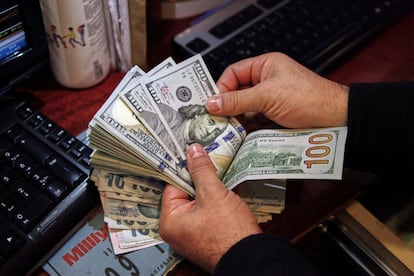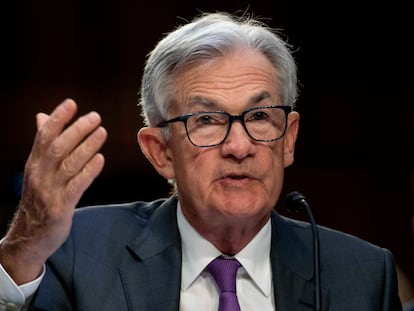Stephen Li Jen, economist: ‘The dollar is the only currency that does not have a linear relationship with its economy’
The co-creator of the ‘Dollar Smile’ hypothesis — devised in 2001 — believes that his theory is still valid today. He thinks the US currency is just as dominant as it was 20 years ago

For months now, the restrictive monetary policy adopted by central banks across the world — and especially by the Federal Reserve — has raised the threat of a recession hitting the United States. While the U.S. economy has shown itself to be resilient, the fear of a slowdown is still alive.
This fear has affected the greenback, which has reached its lowest level (when compared to other powerful currencies, such as the euro) since February 2022. Yet, despite the shaky economic context and signs of currency weakness, the theory of the “Dollar Smile” — devised 22 years ago by Stephen Li Jen and Fatih Yilmaz — has been revived.
Dr. Li Jen, an economist who holds a PhD from MIT, has summarized the behavior of the U.S. dollar in an interview with EL PAÍS: “It’s the only currency that doesn’t have a linear relationship with its economy,” he explains by video call.
The current chief executive of Eurizon Capital SLJ — an asset management firm — believes that the U.S. dollar has always behaved in a peculiar way. To explain it, he gives the example of the German mark, before the arrival of the euro. When the Central European country’s economy was growing faster than its trading partners, the German currency appreciated. “In most countries, that’s how it is. If we plot the relative performance of the economy against its currency on the horizontal axis, we obtain a positive line, with an upward slope.”
By contrast, the Japanese yen and Swiss franc have a negative slope: these are currencies that thrive in times of crisis, as they are considered to be safe-haven assets. The dollar, for its part, strengthens when the U.S. economy grows and there is optimism in the markets, but the greenback also increases in value in a context of global recession, since it’s perceived as a refuge by investors. Hence, it appreciates in bad times and good times, since it’s always considered to be a safe bet. However, in an intermediate context — when the U.S. enters a recession before its counterparts, as during the 2008 financial crisis — investors opt for safer and more profitable assets, meaning that the dollar suffers. “It has a convex relationship with the U.S. economy, in the form of a smile,” Li Jen explains. That’s how the theory gets its name.
The author is convinced that his thesis is still valid. “Arguably, the world has become more multipolar in real terms, especially since the World Trade Organization admitted China in 2001. But, in the financial markets, the dollar is still just as dominant as it was 20 years ago. So we think that this curvature [has been] preserved.”
The validity of his theory can be observed in the current scenario. The rapid decline in U.S. inflation has led the Fed to raise interest rates once again, but the hikes are expected to end soon. This scenario aims to prepare the ground for the overheated U.S. economy to have a soft landing. “This is the worst case scenario for the dollar,” Li Jen argues. In recent weeks, the U.S. currency against the euro has hovered around the lows that it reached in February 2022.
Back in June, the Feds announced that a second interest rate hike in September could be possible. However, the markets are now ruling this out. What’s more, economic analysts foresee only the increase that took place this week, with successive cuts of up to 100 basis points (1%) until the end of 2024. Jen agrees with this reading of the situation. “The Fed fears that inflation — especially core inflation — will remain high. My view is that [inflation] will drop very fast, with [decreases in the prices of] energy, goods, services and housing, although housing is the most stubborn.” In addition, he believes that China will continue to export cheap goods to the rest of the world, especially to the U.S.
Over the last century, the greenback has been the leading currency for international trade and transactions. But the loss of U.S. hegemony has raised the dilemma of global de-dollarization. If the dollar is observed as a reserve currency, its market share has been falling in the last 20 years, with central banks and major financial institutions increasingly holding other currencies. “It’s down from 70% to about 60% now [as a reserve currency]… and it’s still going down,” Li Jen notes. However, from the perspective of the markets, its relevance is indisputable: 88% of all transactions are still carried out in dollars. “Despite the rise of China and India, the introduction of the euro and the petrodollar, the U.S. currency has barely lost market share. It’s shocking,” Jen points out.
However, he identifies a problem that could make the greenback more vulnerable: “The U.S. [runs an annual budget deficit] of over a trillion dollars… we’ve never seen a level this high.” Massive amounts of debt inevitably weaken a country’s currency.
The U.S. Congressional Budget Office warns that the country’s total debt will approach 200% of GDP before 2050. Given this scenario, Li Jen questions the ironclad health of the dollar, which, in an extreme scenario, could end up in a situation like that of the euro in 2011. “The U.S. is heading in that direction. It won’t be long before it becomes the most indebted country in the world. I don’t think the dollar can perform in the same way if we have that situation.”
Sign up for our weekly newsletter to get more English-language news coverage from EL PAÍS USA Edition









































